What is demand?
Demand is defined as want or willingness of consumers to buy goods and services. In economics willingness to buy goods and services should be accompanied by the ability to buy (purchasing power) and is referred to as effective demand.
Types of demand
Composite demand: It is when a good is demanded for two or more uses. For example oil may be used to run a car or as a fuel in a factory.
Joint demand: It is when two goods are bought together. Mouse is bought with a mouse pad.
Derived demand: It is when demand for one good occurs as a result of demand for another. Example, If more goods are made, more labour is needed. Hence demand for labour is derived demand.
Law of demand
It states that when price increases, the amount demanded will fall and when prices fall, the amount demanded will rise.
This phenomenon when plotted on a graph is known as Demand Curve.
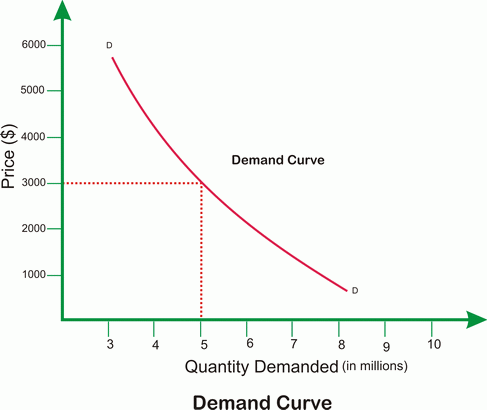
Watch a Video
Movement along the demand Curve
Extension of demand
Extension of demand is the increase in demand due to the fall in price, all other factors remaining constant.
Contraction of demand
Contraction of demand is the fall in demand due to the rise in price, all other factors remaining constant.
Shift in the demand curve
Usually demand curves are drawn based on the assumption except for price all other factors remain the same. But there might be instances when demand may be affected by factors other than price. This will result in the change in demand although the price will remain the same. This change in demand may cause the demand curve to SHIFT inwards or outwards.
- Shift of demand curve OUTWARDS shows an increase in demand at the same price level. It is known as INCREASE IN DEMAND.
- Shift of demand curve INWARDS shows that less is demanded at the same price level. It is known as a FALL IN DEMAND.
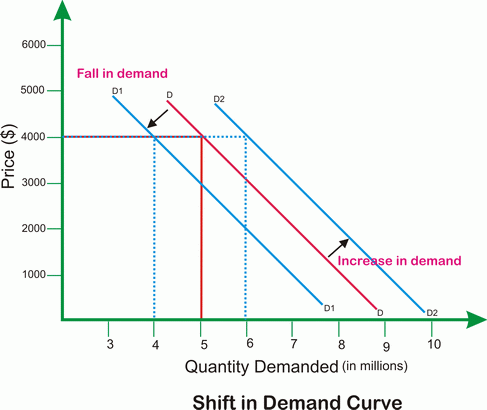
Watch a Video
Factors affecting demand
Change in people’s income: More the people earn the more they will spend and thus the demand will rise. A fall in income will see a fall in demand.
Changes in population: An increase in population will result in a rise in demand and vice versa.
Change in fashion and taste: Commodities or which the fashion is out are less in demand as compared to commodities which are in fashion. In the same way, change in taste of people affects the demand of a commodity.
Changes in Income Tax: An increase in income tax will see a fall in demand as people will have less money left in their pockets to spend whereas a decrease in income tax will result in increase of demand for products and services because people now have more disposable income.
Change in prices of Substitute goods: Substitute goods or services are those which can replace the want of another good or service. For example margarine is a substitute for butter. Thus a rise in butter prices will see a rise in demand for margarine and vice versa.
Change in price of Complementary goods: Complementary goods or services are demanded along with other goods and services or jointly demanded with other goods or services. Demand for cars is affected the change in price of petrol. Same way, demand for DVD players will rise if the prices of DVDs’ fall.
Advertising: A successful advertising campaign may affect the demand for a product or service.
Climate: Changes in climate affects the demand for certain goods and services.
Interest rates: A fall in Interest rate will see a rise in demand for goods and services.
Watch a Video
Price Elasticity of demand
The responsiveness of quantity demanded, or how much quantity demanded changes, given a change in the price of goods or service is known as the price elasticity of demand.
| Price Elasticity of demand (PED)= |
% change in quantity demanded
|
| % Change in price |
Negative sign
The mathematical value which is derived from the calculation is negative. A negative value indicates an inverse relationship between price and the quantity demanded. However, the negative sign is ignored.
Range of PED
The value of PED might range from 0 to ?
Lets take a look at various types of PED.
Perfectly Inelastic demand
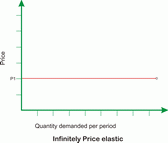
In this case the PED =0 That means, any change in price will not have any effect on the demand of the product. Or in other words, the percentage change in demand will be equal to zero. It is hypothetical situation and does not exist in real world.
Perfectly elastic demand In this case the PED =?
The demand changes infinitely at a particular price. Any change in price will lead to fall of demand to zero. It is hypothetical situation and does not exist in real world.
However Normal goods have value of PED between 0 and ?. These can be classified as Inelastic demand When a product has a PED less than 1 and greater than 0, it is said to be have an inelastic demand. The percentage change in demand is less than the percentage change in price of the product.

Demand for a product is said to be ELASTIC if the percentage change is demand is more than the percentage change in price.
The value of PED is more than 1.
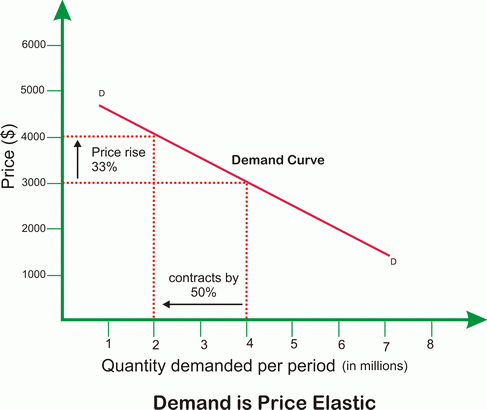
When there is a smaller percentage change in quantity demanded as compared to the percentage change in its price, the product is said to price INELASTIC.
The value of PED is less than 1.
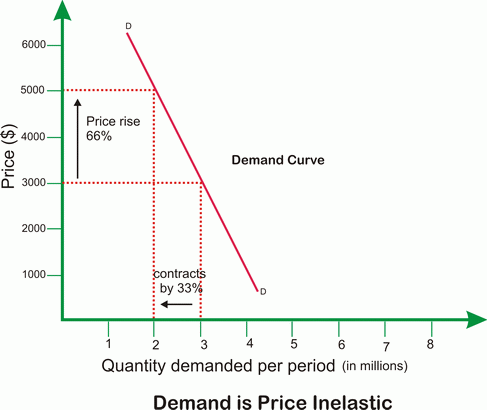
Unitary Elastic Demand
When the percentage change in demand is equal to the percentage change in price, the product is said to have Unitary Elastic demand. In short, PED=1

Watch a Video
Cross price elasticity of demand (XED)
Cross elasticity of demand is
the effect on the change in demand of one good as a result of a change in price of related to another product.
In economics, it is denoted by the symbol XED.
The formula for cross elasticity of demand is
| Cross elasticity of demand = |
% change in quantity demanded of good X
|
| % Change in price of good Y |
In XED it is important to have the positive/negative sign in front of the value.
If the value of XED is positive, this means that the two goods being considered are substitute goods.
Close substitutes have high positive value. Example: butter and margarine.
If two goods are complements, an increase in the price of one will lead to a reduction in the demand for the other—the XED is negative.
Very close complements have a lower negative value.
If two goods are unrelated, a change in the price of one will not affect the demand for the other—the XED is zero.
Watch a Video
Income elaticity of demand
The Income Elasticity of Demand (YED) measures the rate of response of quantity demand due to a raise (or lowering) in a consumers income.
| Income elasticity of demand= |
% change in quantity demanded
|
| % Change in Income |
Normal goods: an increase in income leads to an increase in consumption, demand shifts to the right. Thus YED is positive for normal goods.
Inferior goods: Income elasticity is actually negative for inferior goods, the demand curve shifts left as income rises. As income rises, the proportion spent on cheap goods will reduce as now they can afford to buy more expensive goods. For example demand for cheap/generic electronic goods will fall as people income rises and they will switch to expensive branded electronic goods.
{xtypo_info}Distinguish, with reference to YED, between necessity (income inelastic) goods and luxury (income elastic) goods.{xtypo_info}
Basic or necessity goods have a low income elasticity i.e., 0 < ? < 1. Quantity demanded will not increase much as income increases (income elasticity for food = 0.2)
Luxury goods have high income elasticity i.e. ? > 1. Quantity demanded rises faster than income. For restaurant meals income elasticity is higher than for food, because of the additional restaurant service.

In different types of economies, the demand for goods and services are determined by the income elasticity. As economies grow, firms will want to avoid producing inferior goods. The reason being as income increases more and more people will switch from inferior goods to superior goods.






